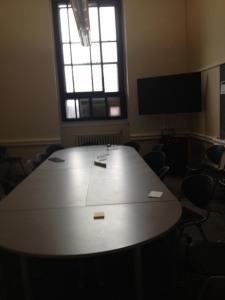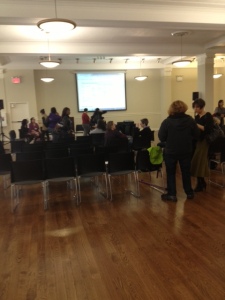“It is the nature of privilege to find ever deeper places to hide.”
Elizabeth Spelman
I was in New Orleans last weekend to participate on a panel at the College Language Association’s annual conference. It was magnificent in so many ways. I heard great papers and talks, met academic pioneers, sighed during Edwidge Danticat’s keynote, and ate my weight in fried shrimp. I danced to someone named Trombone Black at a juke joint in the 7th Ward and wandered around the French Quarter in the rain. There were beignets.
CLA is not a conference I normally attend. You’re more likely to find me at the British Women Writers Conference, the annual Narrative conference or, from time to time, NASSR. But when Janeen Price and Jenice Hudson, two doctoral candidates at Florida State University, asked me to participate on a panel about how women of color navigate the academy (Creolizing the Academic Space: A Roundtable), I said yes. I wanted the opportunity to put my posts and conversations about what I’ve come to think of as “Women’s Studies Culture” into a more useful context and I wanted to talk about my ideas with a diverse group of women of color from different corners of the academy. We were charged with sharing our experiences as a way to offer perspectives and strategies for other women of color. I chose to focus on gender and diversity.
In my thinking about the challenges women of color face when working with white women in the academy, I’ve shifted away from talking about “white women” as a monolithic group and towards discussing Women’s Studies Culture. Not only is this phrase a more precise description of the struggle, it points to a larger systemic problem—one that Jane Chin Davidson and Deepa S. Reddy discuss in their essay “Performative Testimony and the Practice of Dismissal” in Written/Unwritten. It allows for the fact that this struggle goes at least as far back as the eighteenth century when white women like Mary Wollstonecraft appropriated the abolitionist movement to forward their own causes. My brief comments focused on the larger cultural shifts outside the academy that trouble the waters within it. I titled my contribution to the panel “The Minefield(s) of Sisterhood: Women’s Studies Culture and Diversity in the Academy” and framed my thoughts with a question from Audre Lorde and an exhortation from bell hooks.
Lorde’s question is one I’ve been carrying around with me for the last year or so. She posed it to the attendees of the 1981 National Women’s Association Conference in a talk titled “On the Uses of Anger: Women Responding to Racism.” After recounting the various ways that white women place themselves and their feelings at the center of conversations about racism, she asks her sisters at the NWSA:
What woman here is so enamoured of her own oppression that she cannot see her heelprint upon another woman’s face? What woman’s terms of oppression have become precious and necessary to her as a ticket into the fold of the righteous, away from the cold winds of self-scrutiny?
I offered my advice, my exhortation from bell hooks in her essay, “Choosing the Margins as a Space of Radical Openness”–an idea I’ve written about here and am exploring more fully in an essay for PMLA:
Marginality [is] much more than a site of deprivation; in fact…it is also the site of radical possibility, a space of resistance. It was this marginality that I was naming as a central location for the production of counter-hegemonic discourse that is not just found in words but in habits of being and the way one lives. As such, I was not speaking of marginality one wishes to lose—to give up or surrender as part of moving into the center—but rather of a site one stays in, clings to even, because it nourishes one’s capacity to resist. It offers to one the possibility of radical perspective from which to see and create, to imagine alternatives, new worlds.
Between Lorde and hooks, I laid out four shifts we need to think about in order to understand what is happening at what feels like a a particularly tense time for women of color and Women’s Studies Culture in the academy:
- Cultural: We have moved away from the Age of Oprah when the most popular black woman in America built an empire around telling middle-class and upper middle-class white women how to “live their best lives” (without really challenging them to question at whose expense those lives are lived) to a time when the most visible black woman in America challenges racial stereotypes every time she walks in a room. Whereas Oprah—attached to a man but not married and with no children of her own, with her history of sexual assault, and her public weight battle—could inspire white women without challenging their notions of white femininity, Michelle Obama has made the kinds of decisions, primarily to put her family before what many see as a traditional professional career, that make white feminists nervous or angry.
- Economic: The fact that white women have benefited more from Affirmative Action than any other group means that despite broader social inequities, they have more power, particularly in the academy, than they have ever had before and the Anne-Marie Slaughter model of trickle-down feminism (what is good for those at the top will eventually be good for those at the bottom) can make it difficult for many to understand their own privilege.
- Institutional: Women’s Studies, or Gender and Women’s Studies, is closer to the center of the academy than it has ever been before, and the closer it gets to the center the more aggressively it subscribes to the same hierarchies that it once challenged, and it does so under the veil of social justice. On this point, I was (and remain) curious to know if the increase of Ethnic Studies departments has meant more and more women of color opting out of Women’s Studies Culture and building their own academic profiles, careers, and, most importantly, agency, largely without white women.
- Social—Women of color have more outlets and opportunities than they have ever had before both to express their frustrations and their anger AND, most importantly, to build solidarity. I think that what was once seen as peer-to-peer dynamics has now been revealed to be part of a larger pattern and the narrative of the “angry black woman” who bullies white woman with her aggressive tone is being regularly challenged and the challenge is happening in public spaces.
If you haven’t attended CLA, you might not know that it was founded 77 years ago when the MLA excluded black faculty (in practice if not in policy) from its membership. This is one of the reasons why it’s a conference that matches the kind of papers, talks, and discussions we seek at these kinds of gatherings with an air of celebration. It is a conference that turned marginalization into a radical and creative act. Our panel include: Karla Holloway (Duke University), Judy Jackson (University of Kentucky), Theri A. Pickens (Bates College), Rhea Lathan (Florida State University). The room was pretty full. Every speaker, from the untenured assistant professors to the mid-career faculty to senior colleagues, shared experiences that resonated with others on the panel and those who spoke during the Q&A. Well, it wasn’t actually a Q&A session. It was something else entirely. As the panel participants shared their thoughts, people moved beyond the academic knowing nod (you know what I’m talking) to actual exclamations and sighs. This spilled over into the Q&A in ways that surprised me and gave me concrete reminders about how important it is to articulate these challenges within institutionalized academic spaces.
I think that if you were to walk up to anyone in that room and asked them if racism and sexism was shaping how they moved through the academy, they would say yes and then inform you that water is still wet. But it’s one thing to know a truth, to know that microaggression and systemic discrimination are real, and it’s another thing to have your individual experience affirmed. I think it was that specific kind of affirmation that made this more than an academic, theoretical discussion. After the panel ended, some people came up to ask the panelists for advice. Most just wanted to hug us and tell us their stories. There are so many, too many.
I wanted to give folks a bibliography they could take back to their home institutions, either to read on their own or to read with whatever trusted colleagues they can find. Here it is:
Gender, Race, and Feminism
A Short Bibliography
Accapadi, Motwani Mamta. “When White Women Cry: How White Women’s Tears Oppress Women of Color.” The College Student Affairs Journal. 2007 (26:2): 208-215.
Daniels, Jessie.“The Trouble with White Women.”
hooks, bell. “Choosing the Margins as a Space of Radical Openness” in Yearning: Race, Gender, and Cultural Politics. South End Press (1990).
Lorde, Audre. “The Uses of Anger: Women Responding to Racism” Keynote: National Women’s Studies Association (1981).
Mohanty, Chandra Talpade. Feminism without Borders: Decolonizing Theory, Practicing Solidarity. Duke University Press (2003).
Ortega, Marina. “Being Lovingly, Knowingly Ignorant: White Feminism and Women of Color.” Hypatia 21:3 (Summer 2006): 56-74.
Palmer, Phyllis. Marynick. “White Women/Black Women: The Dualism of Female Identity and Experience in the United States.” Feminist Studies 9:1(Spring, 1983): 151-170.
Sandoval, Chela. “U.S. Third World Feminism: The Theory and Method of Oppositional Consciousness in the Postmodern World.” Genders: Journal of Social Theory, Representation, Race, Gender, Sex (1991): 1-24.*
Spelman, Elizabeth. Inessential Woman: Problems of Exclusion in Feminist Thought. Beacon Press (1988).
Williams, Patricia. The Alchemy of Race and Rights: Diary of a Mad Law Professor. Harvard University Press (1991).
*I’m grateful to Annick T.R Wibben for pointing me to this essay.



